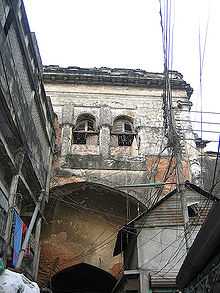Choto Katra
.jpg)
Choto Katra (Bengali: ছোট কাটারা; Small Katara) is one of the two Katras built during Mughal's regime in Dhaka, Bangladesh. It was constructed in 1663 by Subahdar Shaista Khan. It is on Hakim Habibur Rahman lane on the bank of the Buriganga River. Basically it was built to accommodate some officials and Shaista Khan's expanding family. Choto Katra is slightly smaller than Bara Katra, but similar in plan and it is about 185 metres east to it.

Origin
Katara is a form of cellular dormitory built around an oblong courtyard; the form originated in Persia, and like many other things Persian and middle-Asian that the Mughals introduced in this subcontinent, this was copied in Northern India, the home of some of the rulers, members of the Royal Court and the nobility. However, the term may have been derived from Arabic word Katara which meant colonnaded building, or could be a corrupt French word used for a residential quarter. Other synonyms of it are Chuttre (French) and Chatrra (Hindi), both meaning Umbrella, were used for a place that sheltered Pilgrims.

Architecture
Exterior design
The Katra is rectangular in plan, 101.20m X 92.05m externally and 81.07m X 69.19m internally. The thickness of the outer walls is 0.91m to 1.00m and the maximum thickness of the bastion walls is 1.22m. It has two gateways - to the north and south. The southern one is the main entrance. Both the gateways, though much altered recently are still in dire condition. there are two octagonal towers in the two outer corners of the south wall of the structure.
The structures around the courtyard have undergone much renovation, reconstruction and repair. It is evident that the structure has lost much of its original given it some durability. Many modern extensions were also added to the original building. The three storied gateway on the river side has assumed some colonial features. The triple windows and the lofty angle towers reflect the colonial influence during subsequent restoration.
Interior design
Inside, there is a tomb of Champa Bibi, but there is no correct history regarding her identity. There was a small mosque within its enclosure which is ruined. The one-dome square Mausoleum of Champa Bibi, a listed building now, was within its enclosure which was raged to ground by Padre Shepherd. It was later reconstructed by the archaeologists, but now lost within mazes of shops at Champatali. From D’oyle’s drawing who mistook the structure as a mosque, it looked like a multi-foil saucer dome with slim corner spandrels. Champa Bibi was either Shaista Khan’s daughter or a local concubine whom he later married. Shaista Khan’s Bengali heirs from Champa Bibi’s lineage used to live in Choto Katra for many years as Shaista Khan owned Katra.
History
Choto Katra was built in between 1663 and 1671. During the first reign of Shaista Khan, then Subahdar of Bengal and a patron of civic and religious building that gave to the architectural style appropriately named after him.
Since the shift of Mughal capital in 1713, the Katra started to lose its importance along with the city, though the Naib Nazim Jissarat Khan briefly stayed here before his palace, or rather a mansion of which nothing much is now left, was built in 1765 in Nimtali in city just overcoming anarchy.
The British made some additions to the Choto Katra, once used by the first English Medium School in Dhaka (1816) set up by Padre Leonardo, and then the first normal school (1857). The Nawabs of Dhaka rented the places as a coal and lime go-down for sometime. Accounts by Charles D’oyle in 1822 testify to the beauty of the partly surviving Bara Katra, plundered by the poor inhabitants who are still there. Attempts by the archaeology department in the past to take over the structure and restore it to its original glory have been unsuccessful, mainly thwarted by the people who are running a madrasa by illegally occupying a part of the structure.
Besides this Katra, there was several more such cellular structures mainly used as inns or residential enclaves, for example Maya Katra, Muqim Katra, Nawab Katra, etc. These Katras are the few reminiscences of residential quarters in Dhaka or elsewhere in Bengal built during Mughal period.
See also
References
- Ahmed, Nazimuddin, Buildings of the British Raj in Bangladesh, Edited by John Sanday, University Press Limited, 1st Edition, Page no. 46-49, ISBN 984-05-1091-6
- Mamun, Muntasir, Dhaka: Smriti Bismritir Nagari, 3rd Edition, Page No: 201-206, ISBN 984-412-104-3
- Rahman, Mahbubbur. City of an Architect. Dhaka: Delvistaa Foundation. ISBN 978-984-33-2451-1
- Ahmed, Nazimuddin, Islamic Heritage of Bangladesh (Dhaka, 1980: Ministry of Information and Broadcasting)
| Wikimedia Commons has media related to Choto Katra. |